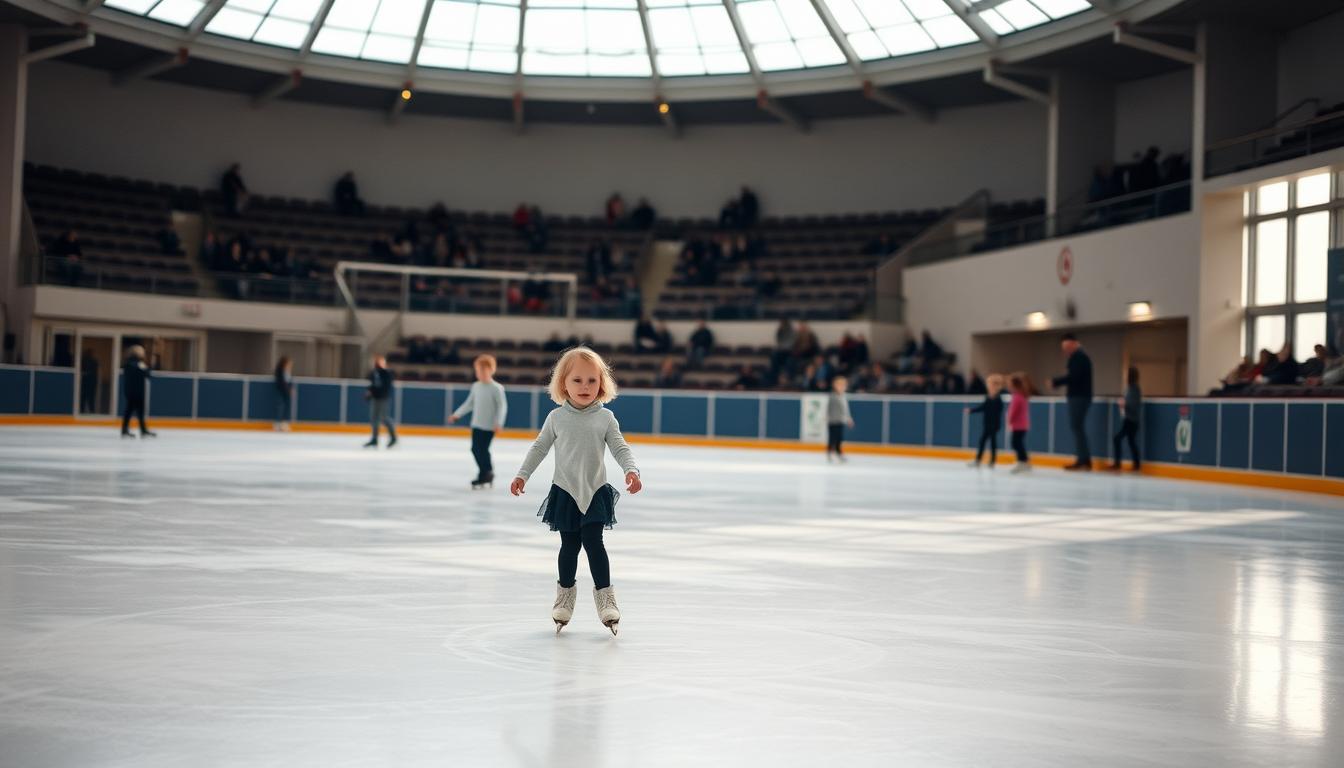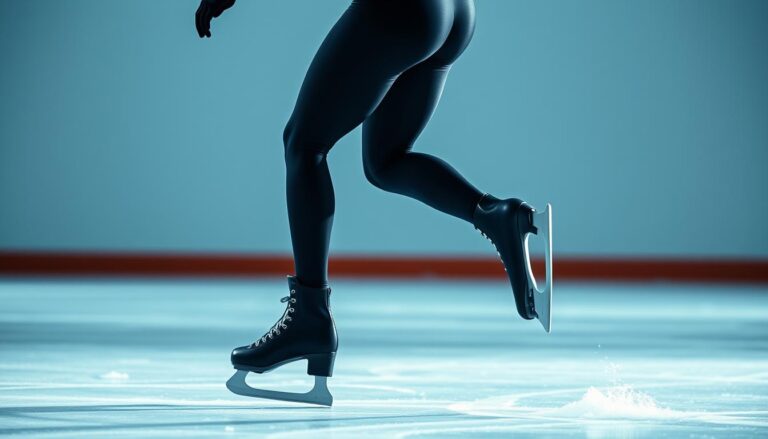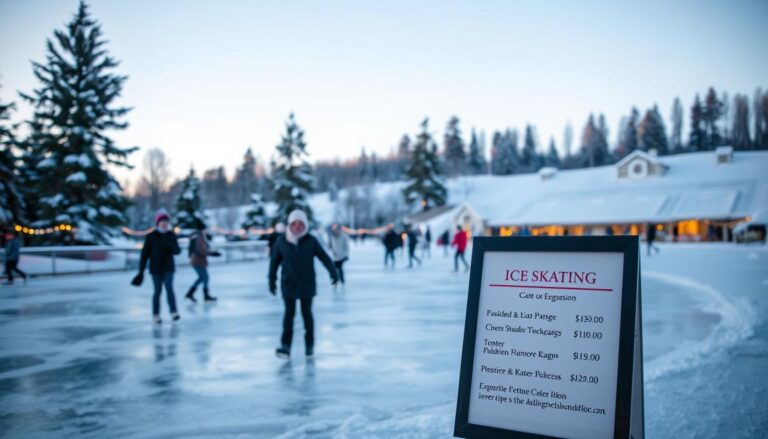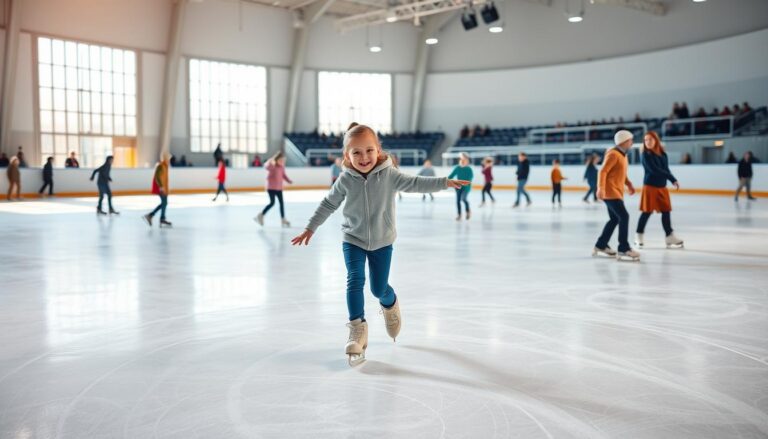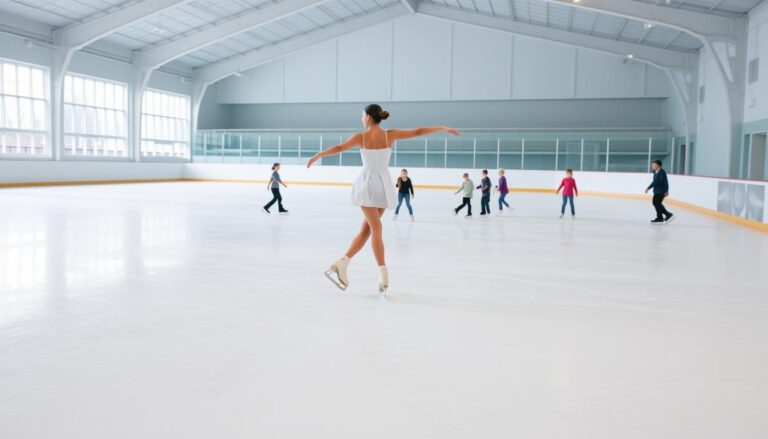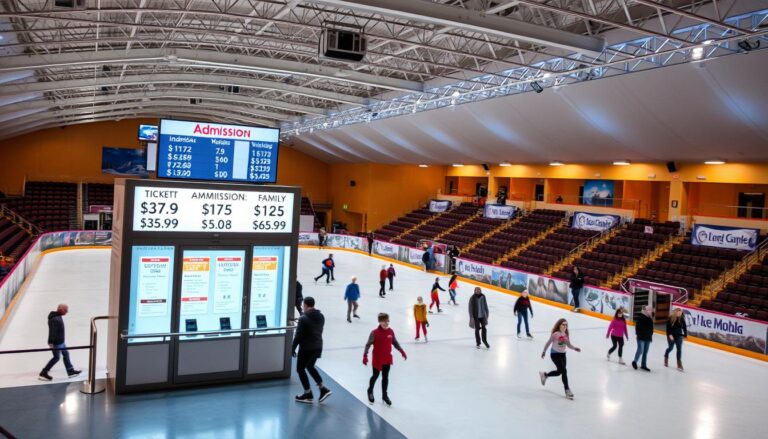How Long Does It Take to Learn Ice Skating?
Ice skating can seem scary for beginners. The time it takes to get good varies a lot. It depends on your skills, how hard you practice, and your natural ability.
Some people learn the basics in a few weeks. Others might take months to feel at ease on the ice. Beginners usually practice for 10-15 hours to learn basic moves.
Many things affect how fast you learn to skate. Your fitness, past sports experience, age, and confidence are all important. Young people might pick it up faster, but adults can also learn with the right teaching and effort.
What you want to achieve also matters. If you just want to move around, you might get there in 4-6 weeks. But if you want to do figure skating or hockey, it could take 6-12 months to get good.
The best skaters are patient and have the right mindset. They know everyone learns at their own pace. Celebrating small wins and staying excited can help you get better faster.
Knowing what to expect and being ready mentally makes ice skating fun and rewarding. Every pro skater was once a beginner. So, enjoy the journey and have fun!
Understanding the Ice Skating Learning Timeline
Starting your ice skating journey needs patience, dedication, and knowing how long it takes to learn. How fast you master ice skating depends on several factors that affect your learning.
Becoming a confident skater involves different stages of skill development. Beginners start with basic techniques that lay the groundwork for more complex movements.
Basic Skills Development
Your first steps in ice skating focus on essential skills for safety and confidence. These include:
- Maintaining balance on skates
- Learning proper standing techniques
- Understanding basic forward movement
- Mastering stopping methods
Factors Affecting Learning Speed
How fast you learn ice skating varies a lot. Several factors can speed up or slow down your progress. These include:
| Factor | Impact on Learning |
|---|---|
| Age | Younger learners often adapt more quickly |
| Physical Fitness | Better core strength accelerates skill acquisition |
| Practice Frequency | More consistent practice reduces learning time |
| Previous Athletic Experience | Transferable skills can speed up learning |
Setting Realistic Expectations
Be realistic about your ice skating journey. Most beginners need 10-20 hours of practice to feel at ease. Mastering advanced techniques like spins and jumps can take months or years.
Remember, every skater’s journey is unique. Your progress is what matters most. Stay patient, enjoy the learning, and celebrate each small victory.
Essential Equipment for Beginning Ice Skaters
Starting your ice skating journey means choosing the right gear. The right equipment supports your learning and keeps you safe.
Finding the perfect ice skates is key. Comfort and fit are essential. Rental skates are good for beginners, but serious skaters should buy a well-fitting pair. This pair should support your ankles and allow smooth movement.
Must-Have Protective Gear
- Helmet (essential for safety)
- Knee pads
- Padded shorts
- Wrist guards
Your protective gear is vital for confidence on the ice. Proper protection reduces fear of falling and lets you focus on learning.
Clothing Recommendations
Dress in layers for easy movement. Choose:
- Thermal base layer
- Lightweight fleece or sweater
- Windproof outer layer
- Moisture-wicking socks
Keeping your equipment in good shape is as important as choosing it. Make sure your skate blades are sharp and clean. Regularly check for wear to ensure safety and performance.
Beginners on a budget can start with rentals. Then, invest in personal gear as you improve your skills.
Physical Requirements and Fitness Levels
Ice skating is more than just skill on the ice. Your physical fitness is key to mastering it. Knowing your body’s limits helps you learn faster.
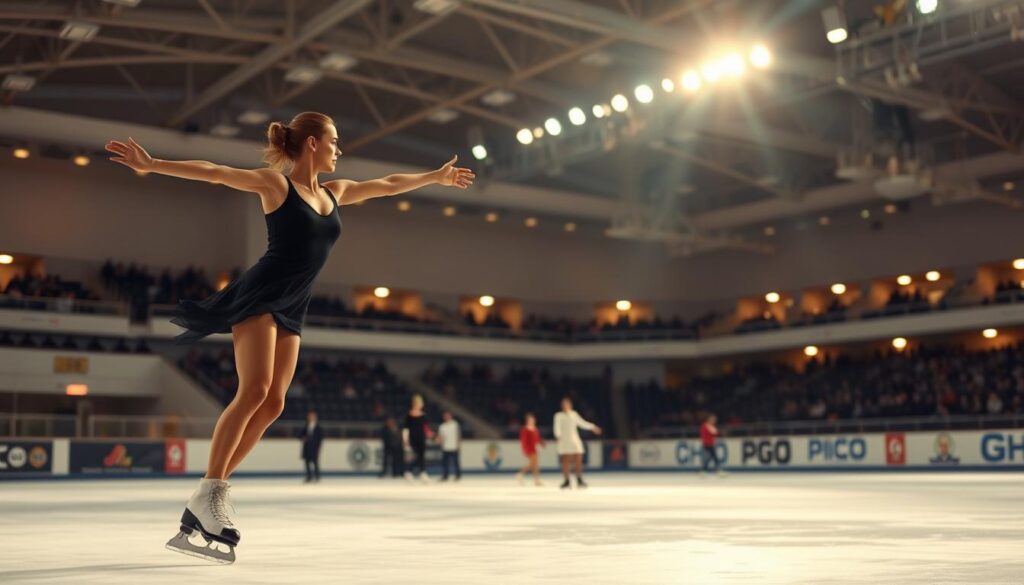
Getting ready for ice skating means getting fit in many ways. You need strong muscles to move smoothly on the ice.
Core Strength Requirements
A strong core is essential for ice skating. Your abs and lower back help with balance and stability.
- Develops critical muscle groups for skating stability
- Helps maintain proper body positioning
- Reduces risk of injury during the learning process
Balance and Flexibility Needs
Ice skating needs great balance and flexibility. Those who work on these skills learn faster and move better.
- Practice yoga or pilates to improve flexibility
- Use balance training exercises
- Incorporate single-leg standing techniques
Cardiovascular Fitness Impact
Being fit in the heart and lungs helps your ice skating. It lets you skate longer and recover faster.
Good cardio activities for ice skating include:
- Running
- Swimming
- Cycling
- High-intensity interval training (HIIT)
Pro tip: Consistent cross-training can significantly accelerate your ice skating learning process speed and overall performance.
Starting with Basic Ice Skating Techniques
Learning ice skating starts with basic techniques. Every skater begins with skills that help them move smoothly on the ice.
Your first step is to get a good skating stance. Stand with your feet apart, knees bent, and weight in the middle. This stance helps you stay stable and ready for different moves.
- Learn the proper body alignment
- Practice maintaining balance
- Understand weight distribution
Falling safely is a key skill. To practice falling, do the following:
- Keep your arms relaxed
- Protect your head
- Slide instead of landing hard
Pro tip: Wear protective gear during initial practice sessions to build confidence and prevent injuries.
Basic skating includes:
- Forward gliding
- Stopping techniques
- Simple turns
- Maintaining balance on edges
How fast you improve depends on your coordination and how often you practice. Keep practicing and be patient to move from basic to advanced skills.
How Long Does It Take to Learn Ice Skating: A Complete Guide
Learning ice skating is an exciting journey that varies for each person. The time it takes to learn ice skating depends on many factors. These include your natural ability, how often you practice, and your athletic skill.
Your journey in ice skating has different stages. These stages help you track your progress and set realistic goals. Knowing how long it takes to learn ice skating can keep you motivated and focused on your goals.
Beginner Milestone Timeline
The first stage of learning ice skating is about building basic skills. Most beginners can learn these skills in:
- 1-2 weeks: Learning to stand and balance
- 3-4 weeks: Basic forward movement and stopping
- 6-8 weeks: Comfortable gliding and basic turning
Intermediate Progress Markers
As you get better, you’ll learn more advanced skills. Skaters usually reach these milestones:
- 2-3 months: Confident backward skating
- 4-6 months: Crossover techniques
- 6-9 months: More complex turning and edge control
Advanced Skill Development
Advanced ice skating techniques need a lot of dedication and practice. Serious learners can master complex skills after:
- 1-2 years: Introductory jumps and spins
- 2-3 years: Refined technical skating skills
- 3-5 years: Competition-level techniques
Remember, these timelines are just estimates and can vary a lot. Your progress depends on your commitment and natural ability. Regular practice and professional instruction are essential to improve faster.
Common Challenges for New Ice Skaters
Learning ice skating comes with its own set of challenges. These can affect how long it takes to learn. New skaters face obstacles that test their will and endurance on the ice.
The biggest hurdles include:
- Fear of falling and possible injuries
- Keeping balance on slippery ice
- Building muscle memory for skating moves
- Overcoming mental doubts and fears
Psychological hurdles are key in your learning journey. Many beginners struggle with confidence. This can slow down their progress.
| Challenge | Impact on Learning | Recommended Strategy |
|---|---|---|
| Balance Instability | Slows Initial Progress | Core strength training |
| Fear of Falling | Limits Skill Advancement | Protective gear and professional instruction |
| Mental Blocks | Reduces Confidence | Visualization and positive self-talk |
Professional skaters say to see challenges as chances to grow. Every obstacle you conquer shortens your learning time. It also builds vital skills.
Physical prep can help a lot. Doing strength training, flexibility exercises, and practicing balance can speed up your learning. It also cuts down on frustration.
The Role of Professional Instruction
Professional instruction can change your ice skating journey a lot. While you can learn on your own, a good coach speeds up your progress. They give you specific advice and teach you expert techniques.
Choosing the right teacher is key to a good learning experience. Coaches know how to improve your skills step by step. They help you overcome obstacles more easily.
Group vs Private Lessons: Pros and Cons
- Group Lessons
- More affordable
- Social learning environment
- Standard skill development
- Private Lessons
- Personalized attention
- Faster skill acquisition
- Customized technique correction
Coaching Impact on Learning Speed
Professional coaches can make you learn faster by setting a clear path. They help you avoid mistakes and build muscle memory quicker.
| Lesson Type | Average Skill Progression | Estimated Learning Time |
|---|---|---|
| Group Lessons | Standard Pace | 3-6 months |
| Private Lessons | Accelerated Pace | 1-3 months |
Investing in professional instruction can make you learn faster. You’ll gain confidence and skills quicker than learning alone.
Practice Frequency and Skill Development
Mastering ice skating takes a smart plan for practice. Regular training turns beginners into skilled skaters. But, it’s more about quality than how much you do.
How often you practice depends on a few things:
- Current skill level
- Personal goals
- Available time
- Physical fitness
Most beginners follow this timeline:
- Beginners: 2-3 sessions a week, 30-45 minutes each
- Intermediate skaters: 3-4 sessions weekly, 45-60 minutes per session
- Advanced learners: 4-5 focused practice sessions
Good practice is key to getting better. Focus on specific skills in each session, not just skating around.
Pro tip: Add off-ice training to your routine. Exercises like strength training, balance, and visualization can speed up your learning. Skaters who do cross-training often get better faster.
Keep track of your progress, set achievable goals, and be patient. Every pro skater began where you are now – at the start of a thrilling journey.
Age-Related Learning Differences
Learning ice skating is a unique journey for everyone. It changes a lot as you get older. Kids and adults have different strengths and challenges on the ice.
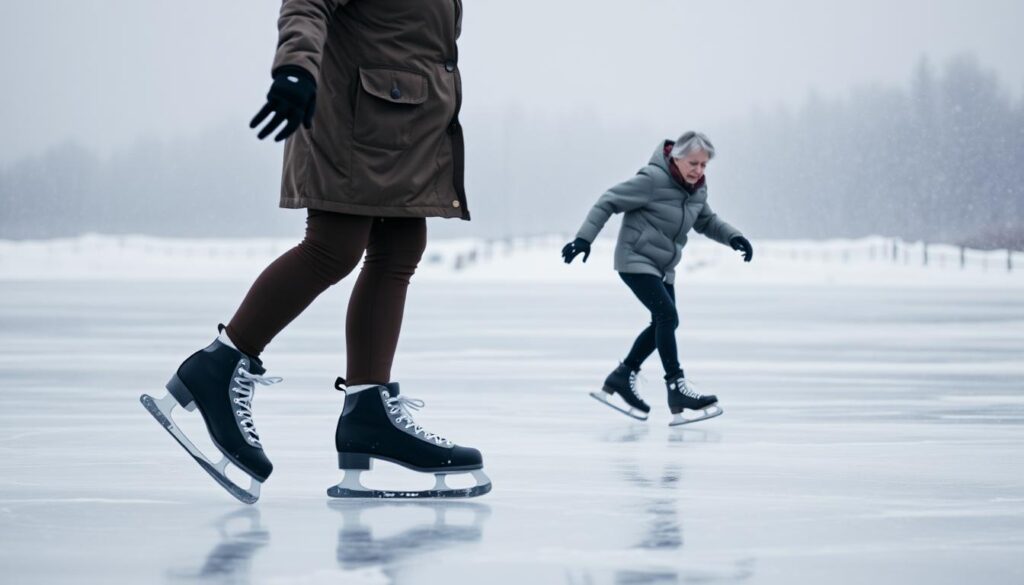
How fast you learn to skate depends on your age. Knowing this can help you set realistic goals for your skating skills.
Children’s Learning Curve
Young learners have big advantages in ice skating:
- Naturally lower center of gravity
- Increased physical flexibility
- Less fear of falling
- Faster muscle memory development
Children pick up new skating skills quickly. Their bodies are flexible, and they’re not afraid to fall. This lets them learn fast.
Adult Learning Considerations
Adults have special strengths for learning ice skating:
- Enhanced body awareness
- Greater mental focus
- Strategic learning approaches
- Developed spatial understanding
Adults might take longer to learn some skills. But they practice harder and learn in a more focused way.
| Age Group | Learning Speed | Key Advantages |
|---|---|---|
| Children (5-12) | Faster | Physical flexibility, Less fear |
| Teenagers (13-19) | Moderate | Growing physical capabilities |
| Adults (20-50) | Slower | Mental focus, Strategic learning |
Age doesn’t matter much in ice skating. What really counts is your passion, practice, and good teaching.
Safety Measures During the Learning Process
Learning to ice skate is not just about mastering moves. It’s also about keeping safe. Every skater must remember that safety is key to feeling confident on the ice.
Wearing the right gear is vital for your skating journey. The right equipment can lower injury risks and make you feel more secure on the ice.
- Helmet (crucial for head protection)
- Wrist guards to prevent fractures
- Padded shorts for hip protection
- Thick, flexible gloves
Learning how to fall safely is important. Skaters should practice falling by:
- Bending knees slightly
- Keeping arms close to the body
- Avoiding using hands to break a fall
- Rolling to the side instead of landing flat
Knowing the rules of the rink is also key to safety. Skaters need to be aware of their surroundings and respect others.
| Safety Skill | Difficulty Level | Practice Time |
|---|---|---|
| Basic Falls | Beginner | 1-2 weeks |
| Protective Equipment Use | Easy | Immediate |
| Rink Awareness | Intermediate | 3-4 weeks |
Remember: Safety isn’t about fear—it’s about smart preparation that empowers your ice skating learning process speed and enjoyment.
Mental Preparation and Psychological Aspects
Ice skating is not just about physical skills. Your mental approach is key to improving quickly. Being mentally ready can make a big difference in how fast you progress and enjoy the sport.
Building Confidence on Ice
Confidence comes from good mental preparation. Skaters know that mental strength is as important as physical skills. Your thoughts and feelings can either help or slow you down.
- Visualize successful skating movements
- Practice positive self-talk
- Set incremental skill goals
- Celebrate small achievements
Overcoming Fear of Falling
Fear is a big obstacle for beginners. Understanding that falling is part of learning helps reduce fear. It makes you more willing to try new things.
- Acknowledge your fear without judgment
- Learn proper falling techniques
- Wear protective gear for confidence
- Start with controlled environments
Mental toughness turns challenges into growth opportunities. See every skating session as a chance to improve both physically and mentally.
Measuring Progress in Ice Skating
![]()
Learning ice skating is more than just time on the ice. It’s important to track your progress to understand your journey. Skaters can use different methods to measure their skills and stay motivated.
The United States Figure Skating Association offers ways to check your progress. They have formal skill tests to help you see how far you’ve come.
- Keep a detailed skating journal to document improvements
- Record video analyses of your techniques
- Participate in skill assessment programs
- Set personal milestones and goals
Visual tracking is key when learning ice skating. Recording your skating sessions on video lets you see your technique, find areas to improve, and celebrate your achievements.
Professional skaters suggest a systematic way to measure your skills. Create a personal checklist that includes:
- Balance and stability
- Stopping techniques
- Forward and backward skating
- Turning and edge control
- Advanced maneuvers
Remember, progress in ice skating isn’t always steady. Some skills come quickly, while others need more time. Stay patient and keep practicing, and you’ll see improvement over time.
Advanced Techniques and Specialized Skills
Getting better at ice skating needs hard work and smart practice. The time it takes to learn advanced skills depends on what you want to do. Whether you love figure skating’s beauty or hockey’s fast pace, it takes time and effort to master.
Skaters know that getting better comes from regular, focused practice. Moving from basic to advanced skills can take 1-3 years. This depends on how well you learn and how often you practice.
Figure Skating Elements
Figure skating is all about being precise and showing your artistic side. Learning advanced moves takes a lot of time and effort.
- Single jumps: 6-12 months of dedicated training
- Double jumps: 1-2 years of practice
- Spin variations: 8-18 months to develop control
- Complex footwork sequences: 1-2 years
Hockey-Specific Skills
Hockey skating is all about being fast, agile, and strong. The time it takes to learn hockey skills depends on your natural ability.
| Skill | Learning Duration | Difficulty Level |
|---|---|---|
| Crossovers | 3-6 months | Intermediate |
| Quick stops | 2-4 months | Beginner |
| Backward skating | 4-8 months | Advanced |
| Lateral movement | 6-12 months | Advanced |
Pro tip: Consistent practice and professional guidance can significantly accelerate your learning curve in advanced ice skating techniques.
Cross-Training Benefits for Ice Skating
Getting better at ice skating takes more than just being on the ice. Cross-training is a great way to boost your skills and performance. It helps improve strength, flexibility, and muscle memory through off-ice activities.
Good cross-training for ice skating covers a few important areas:
- Flexibility development through yoga and stretching
- Core strength training
- Balance and coordination exercises
- Cardiovascular conditioning
Professional skaters know that cross-training can cut down the time it takes to learn. Dance and gymnastics are great because they help with body awareness and precise movements.
| Cross-Training Activity | Primary Skating Benefits | Recommended Frequency |
|---|---|---|
| Pilates | Core strength, balance | 2-3 times per week |
| Strength Training | Muscle power, endurance | 2-3 times per week |
| Ballet | Flexibility, grace, body control | 1-2 times per week |
The goal is to find a balance that works with your on-ice training. By mixing these off-ice activities into your routine, you can learn faster and skate better sooner.
Common Mistakes to Avoid While Learning
Learning to ice skate well takes time and avoiding common mistakes. By learning from others, you can skate better and faster. This helps you enjoy the ice more.
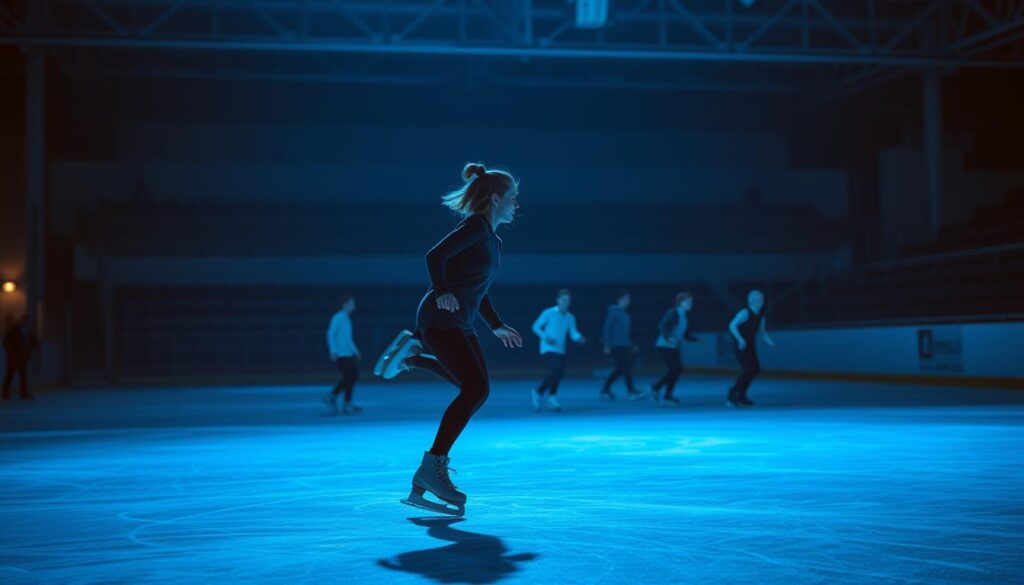
New skaters face many challenges. Knowing these mistakes early helps you skate better and faster. It’s all about learning the right techniques.
Technical Errors to Watch Out For
- Incorrect Posture: Leaning too far back or forward disrupts balance and control
- Stiff body positioning that restricts natural movement
- Improper foot placement and weight distribution
- Neglecting proper edge control and alignment
Training Approach Mistakes
- Practicing without a specific focus or goal
- Skipping essential foundational skills
- Avoiding off-ice conditioning and strength training
- Pushing too hard without proper rest and recovery
Experts say a balanced learning approach is key. By fixing these mistakes, you can skate better faster. A good practice routine helps a lot.
Remember, getting better takes time. Every mistake is a chance to learn and get better. Stay patient, stay focused, and enjoy the journey to becoming a confident ice skater.
Conclusion
Learning ice skating is a personal journey that is unique for everyone. How fast you learn depends on your fitness, how much you practice, and how you learn. You’ll not only get better at skating but also feel more confident and about yourself.
Getting good at ice skating takes time, effort, and love for the sport. It’s not about being perfect right away. Every step you take, whether it’s your first time or you’re getting better, makes you more skilled and passionate about it.
Success in ice skating comes from regular practice, good advice, and staying positive. Enjoy the learning, celebrate your small wins, and keep working towards your goals. Ice skating is a great way to improve yourself, stay fit, and have fun.
Are you ready to start your ice skating adventure? Get the right gear, find a good teacher, and enjoy every practice session. Your journey on the ice is just beginning, and it’s exciting to see how far you can go.
